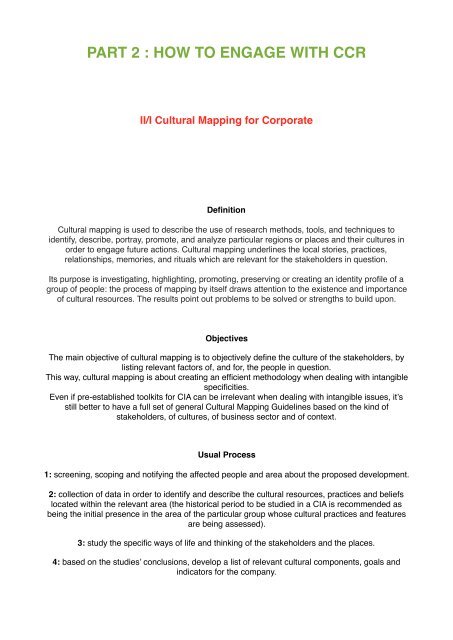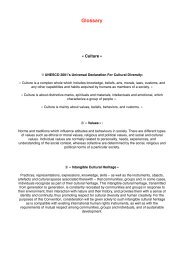Awareness Trainings - Draft #1
You also want an ePaper? Increase the reach of your titles
YUMPU automatically turns print PDFs into web optimized ePapers that Google loves.
PART 2 : HOW TO ENGAGE WITH CCR<br />
II/I Cultural Mapping for Corporate<br />
Definition<br />
Cultural mapping is used to describe the use of research methods, tools, and techniques to<br />
identify, describe, portray, promote, and analyze particular regions or places and their cultures in<br />
order to engage future actions. Cultural mapping underlines the local stories, practices,<br />
relationships, memories, and rituals which are relevant for the stakeholders in question.<br />
Its purpose is investigating, highlighting, promoting, preserving or creating an identity profile of a<br />
group of people: the process of mapping by itself draws attention to the existence and importance<br />
of cultural resources. The results point out problems to be solved or strengths to build upon.<br />
Objectives<br />
The main objective of cultural mapping is to objectively define the culture of the stakeholders, by<br />
listing relevant factors of, and for, the people in question.<br />
This way, cultural mapping is about creating an efficient methodology when dealing with intangible<br />
specificities.<br />
Even if pre-established toolkits for CIA can be irrelevant when dealing with intangible issues, it’s<br />
still better to have a full set of general Cultural Mapping Guidelines based on the kind of<br />
stakeholders, of cultures, of business sector and of context.<br />
Usual Process<br />
1: screening, scoping and notifying the affected people and area about the proposed development.<br />
2: collection of data in order to identify and describe the cultural resources, practices and beliefs<br />
located within the relevant area (the historical period to be studied in a CIA is recommended as<br />
being the initial presence in the area of the particular group whose cultural practices and features<br />
are being assessed).<br />
3: study the specific ways of life and thinking of the stakeholders and the places.<br />
4: based on the studies’ conclusions, develop a list of relevant cultural components, goals and<br />
indicators for the company.




